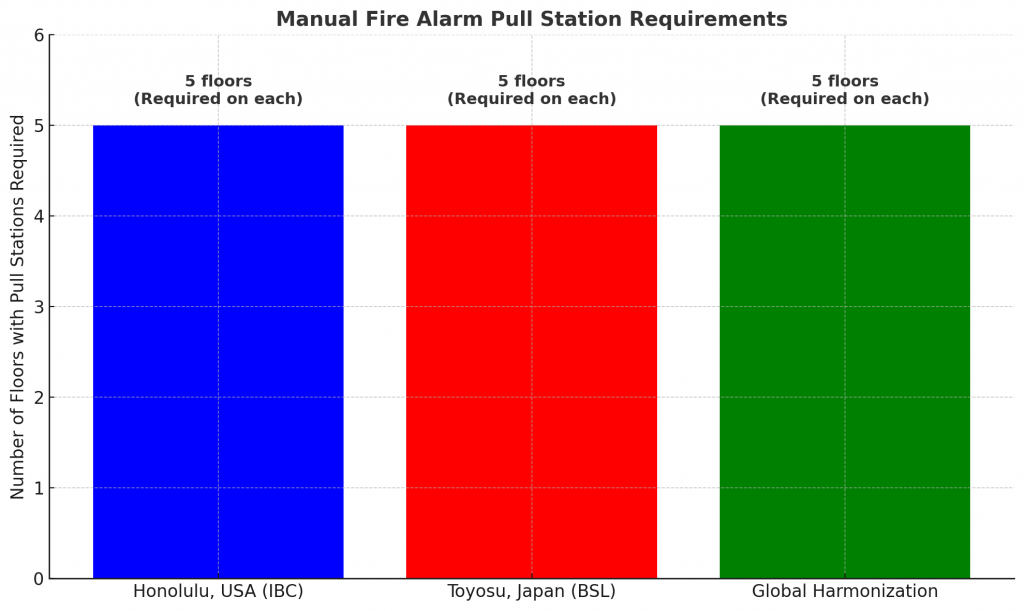General Definitions:
- IBC (International Building Code, USA): Section 907.2.2 requires manual fire alarm pull stations to be installed on each floor of buildings where a fire alarm system is mandated, ensuring building occupants can manually initiate an alarm in case of fire.
- BSL (Building Standard Law, Japan): Article 17 mandates manual fire alarm devices in high-rise and multi-tenant business buildings to support rapid response and effective evacuation procedures.
Comparison Table:
| Criterion | IBC (USA) | BSL (Japan) |
| Manual Pull Station Requirement | Required on each floor of buildings with fire alarms | Required in high-rise and multi-tenant business buildings |
| Basis for Requirement | Building height (floors) and presence of fire alarm system | Occupancy complexity and building classification |
| Scope of Application | Mandatory wherever fire alarms are required | Applies to complex multi-tenant and high-rise structures |
| Compliance and Enforcement | Enforced through inspections per IBC 907.2.2 | Standardized national inspections under Article 17 |
| Flexibility and Adaptability | Prescriptive, per-floor installation requirement | Risk-based, based on building use and structure |
| Testing and Certification | Complies with NFPA 72 | Complies with Japanese Industrial Standards (JIS) |
Key Differences:
- IBC: Requires uniform placement on every floor regardless of building type.
- BSL: More targeted, requiring pull stations in buildings with more complex configurations or taller profiles.
Case Study:
5-Story Office Building
- Honolulu, USA (IBC):
- Manual Pull Stations: Required on each of the 5 floors.
- Toyosu, Japan (BSL):
- Manual Pull Stations: Required if the building is considered high-rise or multi-tenant (which typically applies to commercial offices with shared tenancy).

Global Approach:
- Unified Pull Station Standards:
- Create global minimum requirements for manual fire alarm pull stations in all multi-tenant or high-rise buildings.
- Integrated Risk and Floor-Based Application:
- Combine IBC’s per-floor approach with BSL’s risk-based and building-use criteria.
- Standardized Testing and Certification:
- Harmonize performance benchmarks using both NFPA and JIS standards to support cross-border consistency.
- Ongoing International Collaboration:
- Maintain regular reviews and updates through global safety summits and expert task forces.
- Training and Awareness Programs:
- Implement international educational programs on manual alarm system design, placement, and maintenance for architects, fire officials, and engineers.
IBC and BSL Manual Fire Alarm System as required for “B” Occupancies
IBC Section 907.2.2 Group B. A manual fire alarm system shall be installed in Group B occupancies where one of the following conditions exists:
- 1. The combined Group B occupant load of all floors is 500 or more.
- 2. The Group B occupant load is more than 100 persons above or below the lowest level of exit discharge.
- 3. The fire area contains an ambulatory care facility.
- Exception: Manual fire alarm boxes are not required where the building is equipped throughout with an automatic sprinkler system installed in accordance with Section 903.3.1.1 and the occupant notification appliances will activate throughout the notification zones upon sprinkler water flow.
IBC Section 907.2.2.1 Ambulatory care facilities.
- Fire areas containing ambulatory care facilities shall be provided with an electronically supervised automatic smoke detection system installed within the ambulatory care facility and in public use areas outside of tenant spaces, including public corridors and elevator lobbies.
- Exception: Buildings equipped throughout with an automatic sprinkler system in accordance with Section 903.3.1.1, provided that the occupant notification appliances will activate throughout the notification zones upon sprinkler waterflow.
Japanese Equivalent to IBC Section 907.2.2 (Manual Fire Alarm in Group B)
| IBC 907.2.2 (Group B Occupancy) | Japanese Equivalent |
|---|---|
| Applies to offices and business-type occupancies (Group B) | Offices and business-use buildings under 第1種防火対象物 |
| Requires a manual fire alarm system based on occupant thresholds | Fire alarm systems required based on floor area, use, and building size, under: |
| – Fire Service Act (消防法) | |
| – Cabinet Order Article 4, Item 1 | |
| – BSL Article 17 and enforcement orders | |
| Exceptions when fully sprinklered with notification devices | No automatic exemption — manual alarms often still required, even with sprinklers |
| Authority Having Jurisdiction (AHJ) = local fire/building dept. | Local fire department (消防署) under MLIT jurisdiction |
Relevant Japanese Provisions:
- 消防法 第17条 (Fire Service Act Article 17) – Regulates the installation and type of fire alarm and detection equipment based on building use.
- 建築基準法 第25条 (BSL Article 25) – Addresses fire prevention features (walls, compartmentation).
- 政令第4条 (Cabinet Order Article 4) – Lists which types of buildings require specific fire protection systems, including manual alarms.
